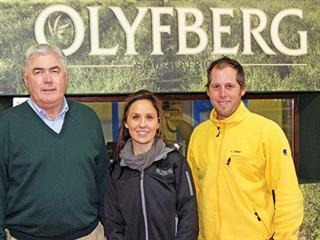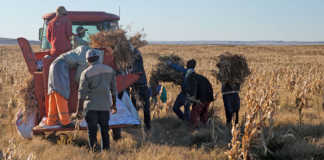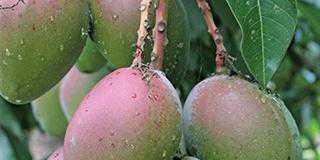
Frikkie Naudé, owner of Olyfberg Olive Estate near Robertson, travelled far and wide researching olive farming conditions in other countries before settling on the Breede River Valley property. Its climate and other growing conditions share similarities with Tuscany, the well-known Italian olive-growing region.
Getting started
Frikkie bought the largely undeveloped farm in 1995 and planted mainly Mission and Manzanilla cultivars. The first olive harvest was in 2001. Farm manager Pieter Kruger says these first two cultivars were chosen primarily because propagation material was readily available. Olyfberg was one of South Africa’s first commercial olive producers, and there was a limited selection of cultivars to choose from at the time.
As more material became available to the local industry, the estate diversified its range of cultivars, at the same time expanding its total area planted to 73ha (about 35 000 trees). Plantings now consist of 30ha Mission (table/ oil), 19ha Manzanilla (table), 15ha Frantoia (oil), about 4ha of Coratina (oil) and approximately 5ha Leccino (oil).
Pest and Disease control
The farm has mainly sandy loam soil, which is ideal for olive farming as it ensures good drainage, explains Pieter. Orchard blocks with insufficient drainage are fitted with subsurface drainage systems to prevent waterlogging.
“One of our biggest disease challenges is Phytophthora root rot,” he says. The occurrence of this disease is exacerbated where periodic waterlogging has taken place.
But Phytophthora can also occur in olive trees growing in well-drained soil if the pathogen is present and environmental conditions are favourable. The leaves of infected trees become yellow and drop, while the stems wilt and die back from the tips. Pieter says Phytophthora can be controlled with potassium phosphate which, when used as a preventive treatment, works primarily by enhancing the plant’s defence mechanisms.
Therefore it is best applied before infection occurs. The Olyfberg team follows a preventive spraying programme using a systemic water- soluble liquid fungicide such as Phosguard. Three olive pests are prevalent in the area: the yellow- and black-striped olive beetle, with its bright yellow larvae that tunnel into leaves, destroying new growth; the olive lace bug, which sucks the sap out of leaves, especially where growth is dense; and the olive fruit fly, controlled through baiting with mercaptothion. The spraying programme runs from August and continues until harvesting.
Irrigation and planting density
Since it is impossible to produce good quality olive oil from poor quality olives, Pieter has geared all production practices towards producing the highest quality olives possible. “We irrigate all the orchards via a micro system using water from the Breede River. Continuous soil moisture logging probes are used to manage the irrigation scheduling,” he explains.
Although one of the oldest agricultural pursuits in the world, olive farming is still relatively new in South Africa.
“We’re still experimenting with planting density and different irrigation practices but generally the most important irrigation period starts in early September before flowering. It then continues until March or April, shortly before
harvesting and the first winter rain,” says Pieter.
Most of the orchards are planted at 5m spacing in the row and with an inter-row spacing of 5m. A few are planted at 4m spacing in the row and with 6m between rows. Pieter is convinced that this density produces better results, and intends using it for future orchards on the estate. The trees are pruned continually, and a single strong leader is maintained in each, ensuring good light penetration.
Fertilising
The fertilisation programme, designed by a consultant, is based on bi-annual soil and annual leaf analysis. Pieter moved away from using only conventional fertiliser, and introduced semi-organic products from Neutrog. Each tree receives 1,2kg of the fertiliser a year, divided into three equal applications: post-harvest, during shoot growth, and at pit-hardening. If needed, additional phosphate is applied as MAP.
Boron and zinc are applied with the other elements in three foliar sprays before flowering, and two foliar sprays after fruit set. A top dressing of potassium oxide (K2O) is applied with a leaf spray towards the end of November at the pit-hardening stage to encourage skin hardening. This helps to prevent bruising.
Production
The average yield of the cultivars varies from about 2t/ ha (Frantoia) up to 9t/ ha (Coratina). Mission, Olyfberg’s most widely-planted variety, has an average annual yield of 7t/ha. Between 10% and 15% (30t to 50t) of the harvest is used for table olives; the rest is for oil.
Last year, Olyfberg produced 50 000l oil, with 6kg fruit yielding roughly one litre. The estate’s award-winning olive oil is a blend of four cultivars: Mission, Frantoia, Coratina and Leccino. These are pressed separately and blended later to craft Olyfberg’s unique extra virgin olive oil.
Ripeness
Fruit ripeness determines the flavour and quality of the oil. To produce good oil, it is important to pick the olives at exactly the right time. Pieter points out that when olives are darker, they provide more flavour, while greener olives ensure freshness and longevity. “The colour of at least 50% of the olive crop picked for oil should have started changing from green to a lighter green – showing a blush of colour – at harvesting time,” he explains.
After being carefully picked by hand, the olives are processed as soon as possible to avoid the outer layer of the skin from fermenting, which may lead to inferior oil. The oil is extracted using a high-tech Pieralisi plant that ensures little oxygen contact, and further refined by passing through a separator. It is then filtered during the bottling process. “We want consumers to trust the Olyfberg trademark, so we’ll never market a product if we are not completely satisfied with its quality,” says Pieter.
Phone Pieter Kruger on 023 342 5096.













